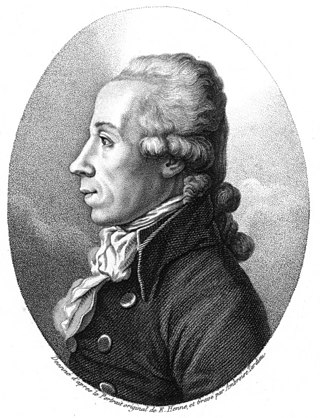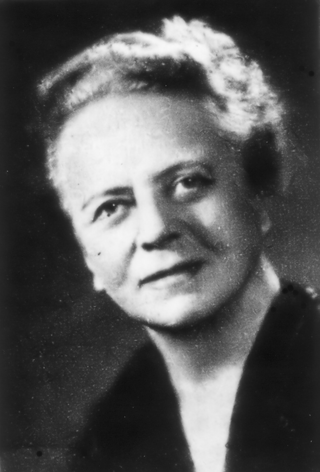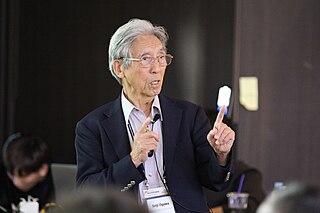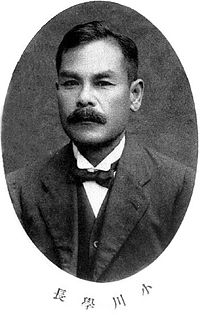Bohrium is a synthetic chemical element; it has symbol Bh and atomic number 107. It is named after Danish physicist Niels Bohr. As a synthetic element, it can be created in particle accelerators but is not found in nature. All known isotopes of bohrium are highly radioactive; the most stable known isotope is 270Bh with a half-life of approximately 2.4 minutes, though the unconfirmed 278Bh may have a longer half-life of about 11.5 minutes.
Hafnium is a chemical element; it has symbol Hf and atomic number 72. A lustrous, silvery gray, tetravalent transition metal, hafnium chemically resembles zirconium and is found in many zirconium minerals. Its existence was predicted by Dmitri Mendeleev in 1869, though it was not identified until 1922, by Dirk Coster and George de Hevesy. Hafnium is named after Hafnia, the Latin name for Copenhagen, where it was discovered.

Rhenium is a chemical element; it has symbol Re and atomic number 75. It is a silvery-gray, heavy, third-row transition metal in group 7 of the periodic table. With an estimated average concentration of 1 part per billion (ppb), rhenium is one of the rarest elements in the Earth's crust. It has one of the highest melting and one of the highest boiling points of any element. It resembles manganese and technetium chemically and is mainly obtained as a by-product of the extraction and refinement of molybdenum and copper ores. It shows in its compounds a wide variety of oxidation states ranging from −1 to +7.

Technetium is a chemical element; it has symbol Tc and atomic number 43. It is the lightest element whose isotopes are all radioactive. Technetium and promethium are the only radioactive elements whose neighbours in the sense of atomic number are both stable. All available technetium is produced as a synthetic element. Naturally occurring technetium is a spontaneous fission product in uranium ore and thorium ore, or the product of neutron capture in molybdenum ores. This silvery gray, crystalline transition metal lies between manganese and rhenium in group 7 of the periodic table, and its chemical properties are intermediate between those of both adjacent elements. The most common naturally occurring isotope is 99Tc, in traces only.
Nihonium is a synthetic chemical element; it has the symbol Nh and atomic number 113. It is extremely radioactive: its most stable known isotope, nihonium-286, has a half-life of about 10 seconds. In the periodic table, nihonium is a transactinide element in the p-block. It is a member of period 7 and group 13.

Martin Heinrich Klaproth was a German chemist. He trained and worked for much of his life as an apothecary, moving in later life to the university. His shop became the second-largest apothecary in Berlin, and the most productive artisanal chemical research center in Europe.

Group 7, numbered by IUPAC nomenclature, is a group of elements in the periodic table. It contains manganese (Mn), technetium (Tc), rhenium (Re) and bohrium (Bh). This group lies in the d-block of the periodic table, and are hence transition metals. This group is sometimes called the manganese group or manganese family after its lightest member; however, the group itself has not acquired a trivial name because it belongs to the broader grouping of the transition metals.

Tohoku University is a public research university in Sendai, Miyagi, Japan. It is colloquially referred to as Tohokudai or Tonpei.
Ogawa is the 30th most common Japanese surname. Less common variants are 小河 or 尾川. Notable people with the surname include:

Edward Divers FRS was a British experimental chemist who rose to prominence despite being visually impaired from young age. Between 1873 and 1899, Divers lived and worked in Japan and significantly contributed to the science and education of that country.

Walter Noddack was a German chemist. He, Ida Tacke, and Otto Berg reported the discovery of element 43 and element 75 in 1925.

Ida Noddack, néeTacke, was a German chemist and physicist. In 1934 she was the first to mention the idea later named nuclear fission. With her husband Walter Noddack, and Otto Berg, she discovered element 75, rhenium. She was nominated three times for the Nobel Prize in Chemistry.

Seiji Ogawa is a Japanese biophysicist and neuroscientist known for discovering the technique that underlies Functional Magnetic Resonance Imaging (fMRI). He is regarded as the father of modern functional brain imaging. He determined that the changes in blood oxygen levels cause its magnetic resonance imaging properties to change, allowing a map of blood, and hence, functional, activity in the brain to be created. This map reflected which neurons of the brain responded with electrochemical signals to mental processes. He was the first scientist who demonstrated that the functional brain imaging is dependent on the oxygenation status of the blood, the BOLD effect. The technique was therefore called blood oxygenation level-dependent or BOLD contrast. Functional MRI (fMRI) has been used to map the visual, auditory, and sensory regions and moving toward higher brain functions such as cognitive functions in the brain.

The Shibaura Institute of Technology, abbreviated as Shibaura kōdai, is a private university with the main campus located in Koto, Tokyo, Japan, with campuses located in Tokyo and Saitama. Established in 1927 as the Tokyo Higher School of Industry and Commerce, it was chartered as a university in 1949.

Otto Berg was a German scientist. He is one of the scientists credited with discovering rhenium, the last element to be discovered having a stable isotope.

Yoshizumi Ogawa is a Japanese retired footballer and assistant manager of Sagan Tosu from 2023.
Masataka is a masculine Japanese given name. Notable people with the name include:
Hiroshi Ogawa is a former Japanese Nippon Professional Baseball shortstop, and current the third squad manager for the Fukuoka SoftBank Hawks of Nippon Professional Baseball (NPB).
Masataka Kubota is a Japanese actor.












